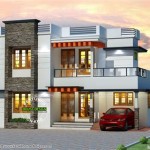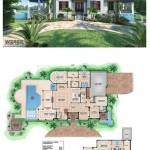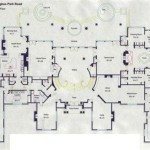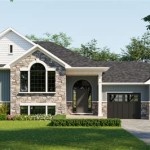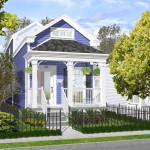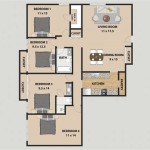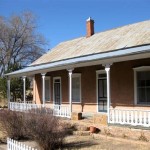Farnsworth House Plants: Harmonizing Nature and Modern Architecture
The Farnsworth House, a seminal work of modern architecture designed by Ludwig Mies van der Rohe, is renowned for its minimalist aesthetic, transparency, and seamless integration with its natural surroundings. The interplay between the built environment and the external landscape is a defining characteristic of the house. While the architectural design itself focuses on simplicity and openness, the thoughtful incorporation of plants, both within and around the house, plays a crucial role in enhancing the overall experience and blurring the lines between interior and exterior.
The selection and placement of plants in and around the Farnsworth House were not arbitrary. They reflect a conscious effort to complement the architectural principles and further emphasize the connection to nature. The landscape design, often attributed to Lanning Roper despite debates surrounding his direct involvement, aimed to create a harmonious relationship between the man-made structure and the natural environment. The planting scheme was meticulously planned to accentuate the house's horizontal lines, frame views of the surrounding landscape, and provide a sense of privacy without obstructing the expansive vistas.
The Role of Plants in Defining Spatial Boundaries
The transparency of the Farnsworth House can present a challenge in terms of privacy and definition of space. While the glass walls offer unparalleled views of the surrounding landscape, they also create a sense of exposure. Plants, both inside and outside the house, serve as subtle yet effective spatial dividers. Trees and shrubs are strategically planted to create visual barriers, softening the transition from the interior to the exterior and providing a sense of enclosure without compromising the open floor plan.
The landscape design employs a variety of plant species to achieve this spatial definition. Tall, slender trees such as river birch and oak, positioned along the perimeter of the property, act as a living screen, filtering light and creating a sense of seclusion. Lower-growing shrubs and ground cover plants define pathways and delineate outdoor living areas, subtly guiding movement and establishing distinct zones within the landscape. The careful placement of these plants enhances the sense of privacy and intimacy, transforming the open, exposed space into a more comfortable and inviting environment.
Inside the house, plants can also be used to define smaller, more intimate spaces. Potted plants or strategically placed flower arrangements can create visual focal points, dividing the large, open living area into smaller, more manageable sections. A tall plant placed near a seating area, for example, can create a sense of enclosure and privacy, making the space feel more comfortable and inviting. The use of plants in this way helps to break up the monotony of the minimalist interior and add a touch of warmth and personality to the living space.
Plant Selection and Aesthetic Considerations
The choice of plants for the Farnsworth House was carefully considered to complement the overall aesthetic of the building and the surrounding landscape. The emphasis was on native or naturalized species that blend seamlessly with the local ecosystem. This approach aligns with Mies van der Rohe's philosophy of simplicity and his desire to create a harmonious relationship between architecture and nature. The use of native plants also promotes biodiversity and reduces the need for excessive maintenance and watering.
The plant palette for the Farnsworth House typically includes a variety of deciduous trees, shrubs, and ground cover plants. The selection includes species that offer seasonal interest, with variations in color, texture, and form throughout the year. This creates a dynamic and ever-changing landscape that enhances the experience of living in the house. Spring flowering trees and shrubs provide a burst of color, while the changing foliage of the deciduous trees in the fall adds warmth and richness to the landscape. Evergreen trees and shrubs provide year-round interest and structure, ensuring that the landscape remains visually appealing even during the winter months.
The aesthetic considerations also extend to the choice of indoor plants. The plants selected for the interior typically feature simple, elegant forms that complement the minimalist aesthetic of the house. The focus is on plants with clean lines and interesting textures, such as orchids, ferns, and succulents. The plants are often displayed in simple, understated pots that do not detract from the overall design. The use of indoor plants helps to bring the natural world inside, blurring the lines between the interior and exterior and creating a more harmonious living environment.
The Ongoing Maintenance and Preservation of the Landscape
The landscape surrounding the Farnsworth House requires ongoing maintenance and preservation to ensure that it continues to thrive and contribute to the overall integrity of the site. The management of the landscape involves a delicate balance between preserving the original design intent and adapting to the changing environmental conditions. The goal is to maintain the health and vitality of the plants while also minimizing the impact on the surrounding ecosystem.
Regular maintenance activities include pruning, watering, fertilizing, and pest control. Pruning is essential for maintaining the shape and structure of the trees and shrubs, as well as for promoting healthy growth. Watering is necessary, especially during dry periods, to ensure that the plants receive adequate moisture. Fertilizing provides essential nutrients that help the plants thrive. Pest control measures are implemented to prevent and manage infestations of insects and diseases that could damage the plants.
In addition to regular maintenance, preservation efforts also focus on protecting the landscape from erosion and other environmental threats. Erosion control measures, such as the installation of retaining walls and the use of erosion-resistant ground cover plants, are implemented to prevent soil loss and protect the integrity of the site. Invasive species are carefully monitored and controlled to prevent them from outcompeting the native plants and disrupting the ecosystem. The ongoing maintenance and preservation of the landscape are essential for ensuring that the Farnsworth House continues to be a harmonious blend of architecture and nature for generations to come.
The integration of plants into the architectural design of the Farnsworth House is a testament to the importance of nature in creating a holistic and enriching living environment. The thoughtful selection, placement, and maintenance of plants contribute significantly to the overall aesthetic, functionality, and sustainability of the site. The harmonious relationship between the built environment and the natural landscape is a defining characteristic of the Farnsworth House and serves as a valuable lesson in the art of integrating architecture and nature. This relationship enhances the living experience and reinforces the connection between humanity and the environment.
The Farnsworth House's landscape continues to evolve, presenting ongoing challenges and opportunities for interpretation and preservation. Understanding the original design intent while adapting to changing environmental conditions is crucial for ensuring that the landscape continues to complement and enhance the architectural masterpiece that is the Farnsworth House.
Farnsworth House Installation Replicates Original Decor Of Edith
Farnsworth House Data Photos Plans Wikiarquitectura
Farnsworth House Data Photos Plans Wikiarquitectura
Ad Classics The Farnsworth House Mies Van Der Rohe Archdaily
Farnsworth House Architecture
Farnsworth House Peter Guthrie
A Second Look At Edith Farnsworth And Her Mies Van Der Rohe Designed Retreat 2024 07 15 Architectural Record
Mies Van Der Rohe S Farnsworth House Postcard Book Cac Design
The Edith Farnsworth House By Ludwig Mies Van Der Rohe Plano Illinois
Mies Van Der Rohe S Farnsworth Lasers House Fabric Architecture Studio

